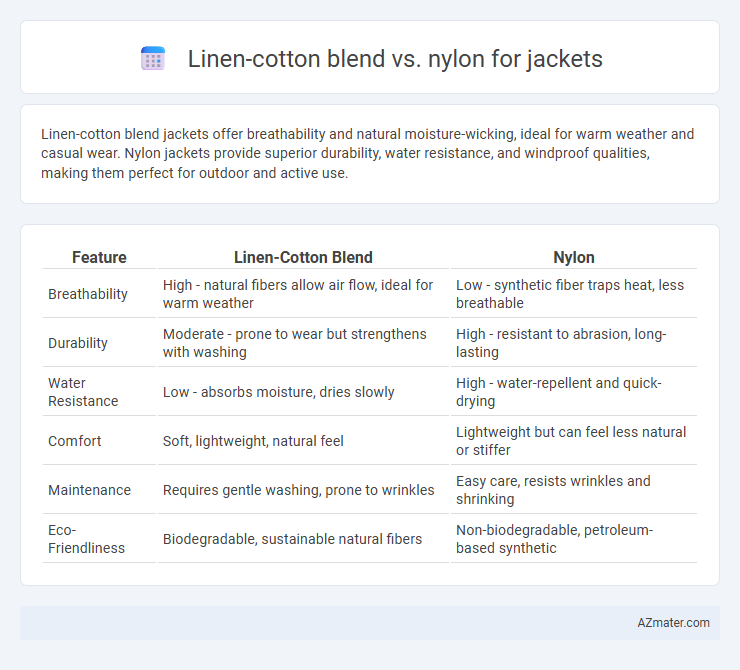Linen-cotton blend jackets offer breathability and natural moisture-wicking, ideal for warm weather and casual wear. Nylon jackets provide superior durability, water resistance, and windproof qualities, making them perfect for outdoor and active use.
Table of Comparison
| Feature | Linen-Cotton Blend | Nylon |
|---|---|---|
| Breathability | High - natural fibers allow air flow, ideal for warm weather | Low - synthetic fiber traps heat, less breathable |
| Durability | Moderate - prone to wear but strengthens with washing | High - resistant to abrasion, long-lasting |
| Water Resistance | Low - absorbs moisture, dries slowly | High - water-repellent and quick-drying |
| Comfort | Soft, lightweight, natural feel | Lightweight but can feel less natural or stiffer |
| Maintenance | Requires gentle washing, prone to wrinkles | Easy care, resists wrinkles and shrinking |
| Eco-Friendliness | Biodegradable, sustainable natural fibers | Non-biodegradable, petroleum-based synthetic |
Introduction to Jacket Fabric Choices
Linen-cotton blend jackets offer breathability, natural moisture-wicking, and a soft texture ideal for warm weather, combining linen's lightweight feel with cotton's durability. Nylon jackets provide superior water resistance, windproof capabilities, and enhanced durability, making them suitable for outdoor activities and harsher conditions. Choosing between linen-cotton blend and nylon depends on climate, intended use, and desired comfort level.
What is a Linen-Cotton Blend?
A linen-cotton blend combines the natural breathability and moisture-wicking properties of linen with the softness and durability of cotton, creating a lightweight, comfortable fabric ideal for jackets in warm climates. This blend offers enhanced wrinkle resistance and a smoother texture compared to pure linen, while maintaining excellent airflow and absorbency. Compared to nylon, which is synthetic, the linen-cotton blend provides superior breathability and a more natural feel, making it preferable for casual or summer outerwear.
Understanding Nylon Fabric Properties
Nylon fabric offers exceptional durability, water resistance, and lightweight performance, making it an ideal choice for jackets designed for active use and harsh weather conditions. Its high tensile strength and abrasion resistance surpass those of linen-cotton blends, providing enhanced protection and longevity. While linen-cotton blends excel in breathability and comfort, nylon's moisture-wicking properties and quick-drying capabilities ensure superior functionality in outdoor and performance outerwear.
Comfort and Breathability Comparison
Linen-cotton blend jackets offer superior breathability and natural moisture-wicking properties, making them ideal for warm weather and extended wear. In contrast, nylon jackets provide water resistance and durability but tend to trap heat and reduce airflow, which can cause discomfort during prolonged use. Choosing linen-cotton enhances comfort with its lightweight, breathable fabric, while nylon prioritizes protection over breathability in jacket design.
Durability: Linen-Cotton Blend vs Nylon
Nylon jackets offer superior durability due to their high tensile strength, abrasion resistance, and ability to withstand harsh weather conditions, making them ideal for long-term use and outdoor activities. Linen-cotton blends, while breathable and comfortable, lack the same level of toughness and abrasion resistance, making them prone to wear and tear over time. For durability-conscious consumers, nylon provides a more resilient and long-lasting fabric choice compared to linen-cotton blends in jacket construction.
Weather Resistance: Which Fabric Performs Better?
Linen-cotton blends offer moderate water resistance but excel in breathability and moisture absorption, making them ideal for mild, dry conditions. Nylon outperforms linen-cotton blends in weather resistance due to its superior water repellency, windproof qualities, and quick-drying properties, making it suitable for rain and harsh weather. For jackets prioritizing all-weather protection, nylon is the better-performing fabric.
Style and Appearance Differences
Linen-cotton blend jackets offer a natural, breathable, and textured appearance ideal for casual and warm-weather styles, featuring a matte finish and soft drape that enhances relaxed elegance. Nylon jackets present a sleek, shiny surface with a smooth, lightweight structure, often associated with sporty or urban fashion, providing a modern and polished look. The contrast between the two lies in linen-cotton's organic, textured appeal versus nylon's synthetic, high-performance finish, influencing their overall style versatility and aesthetic presence.
Maintenance and Care Requirements
Linen-cotton blend jackets require gentle washing with mild detergent to preserve fabric softness and texture, while avoiding high heat drying to prevent shrinkage. Nylon jackets benefit from easy maintenance with quick drying and high durability against stains but need careful washing to maintain water resistance and avoid fabric damage from harsh chemicals. Proper storage away from direct sunlight extends the lifespan of both fabrics by preventing fading and fiber weakening.
Eco-Friendliness and Sustainability
Linen-cotton blend jackets offer superior eco-friendliness due to their natural, biodegradable fibers that require less water and pesticides compared to conventional cotton alone. Nylon jackets, while durable and lightweight, rely on petroleum-based synthetic materials with higher carbon footprints and limited biodegradability. Choosing linen-cotton blends supports sustainable agriculture practices and reduces microplastic pollution associated with synthetic fabrics like nylon.
Which Jacket Fabric is Best for You?
Linen-cotton blend jackets offer breathability, natural moisture-wicking, and a soft texture ideal for warm weather and casual wear, while nylon jackets provide superior water resistance, durability, and wind protection suited for outdoor and active use. Consider your climate and activity level: choose linen-cotton blends for comfort and style in mild conditions, or opt for nylon when prioritizing weather resistance and lightweight performance. Fabric breathability, maintenance, and intended use are key factors in selecting the best jacket material.

Infographic: Linen-cotton blend vs Nylon for Jacket
 azmater.com
azmater.com